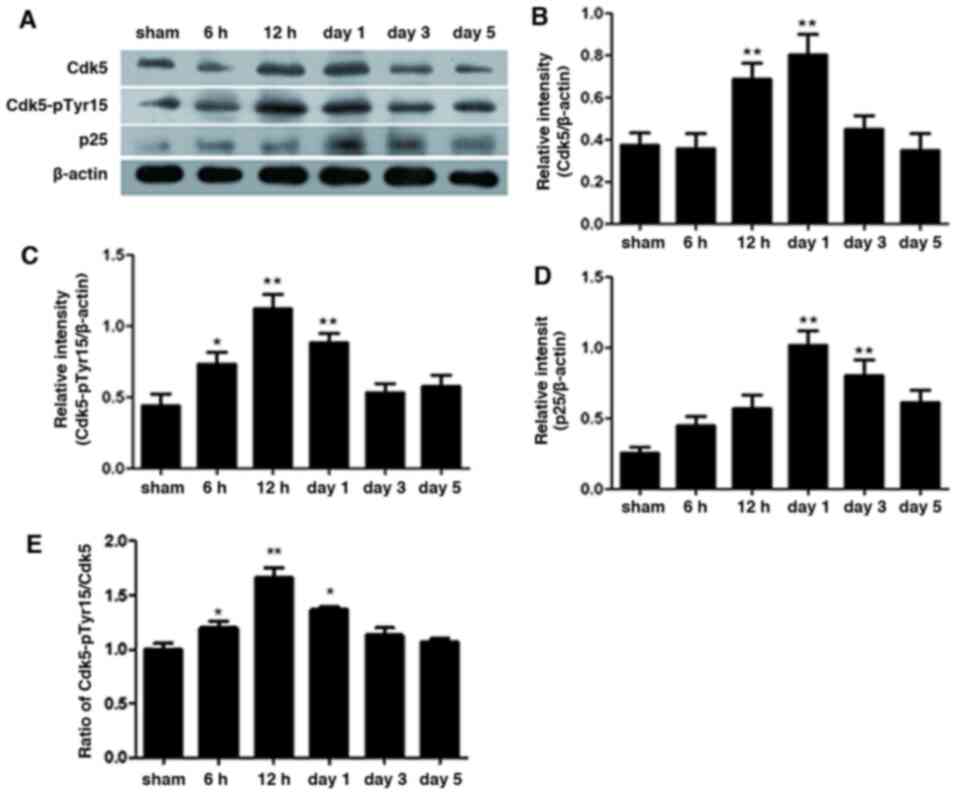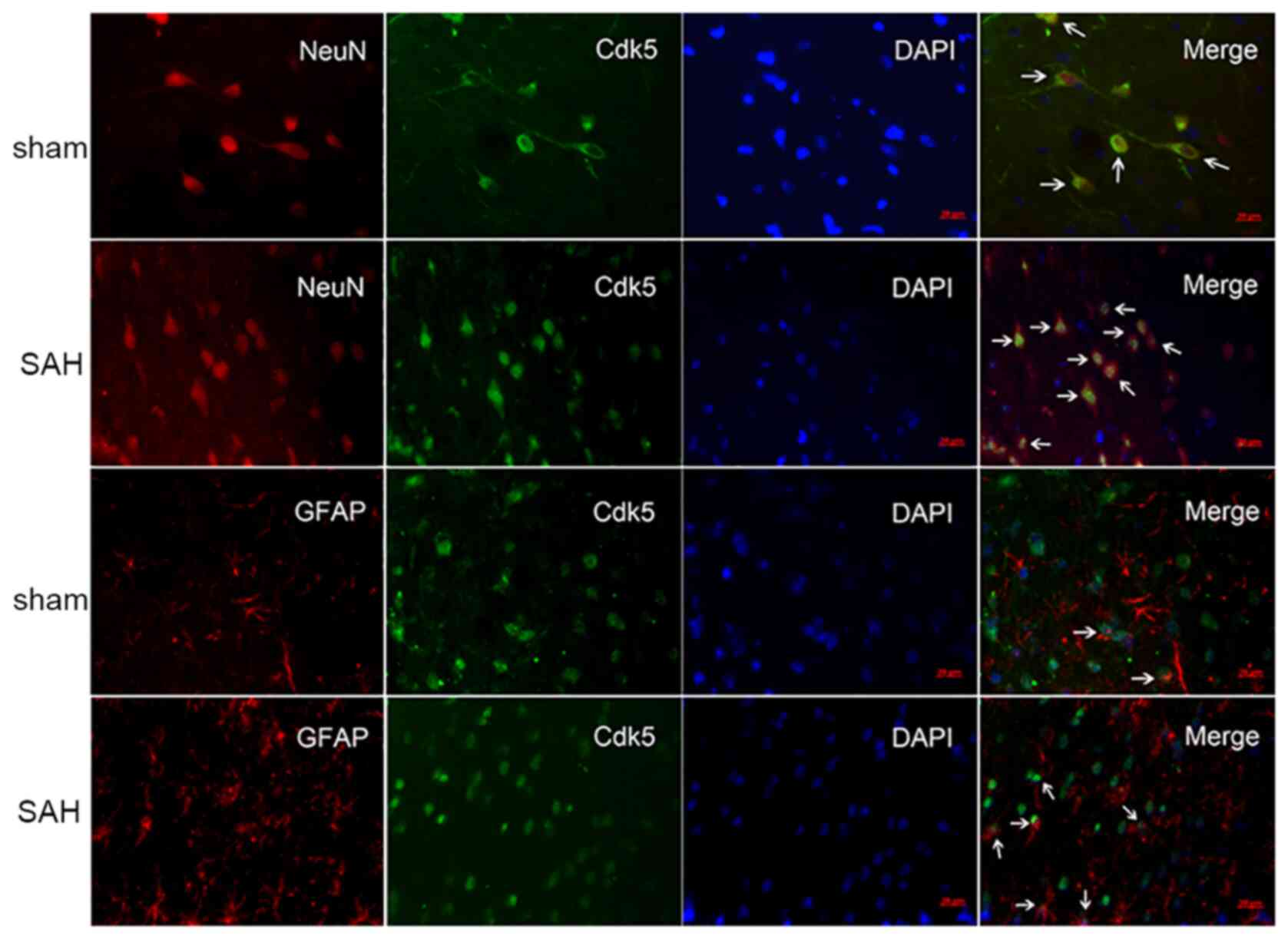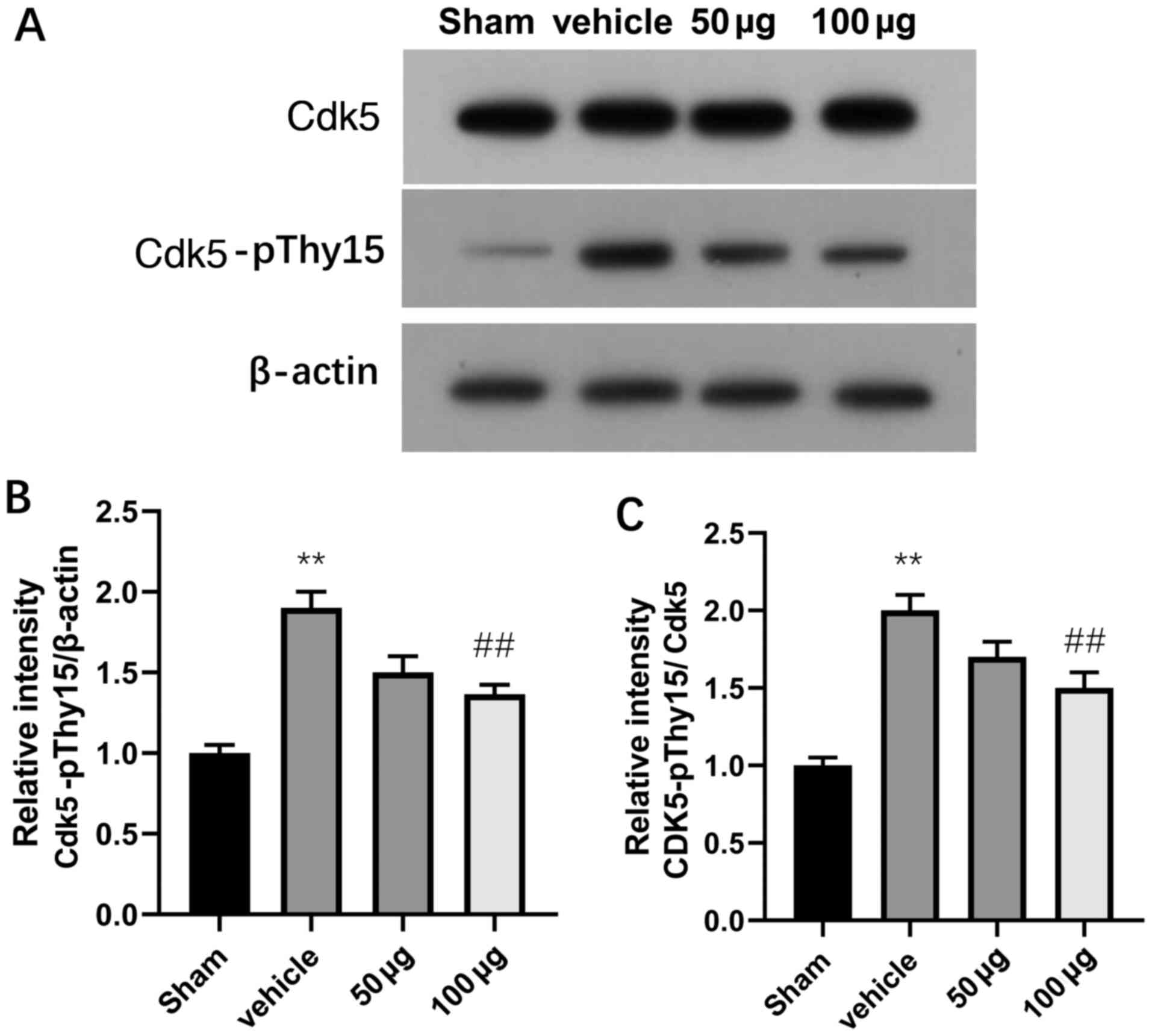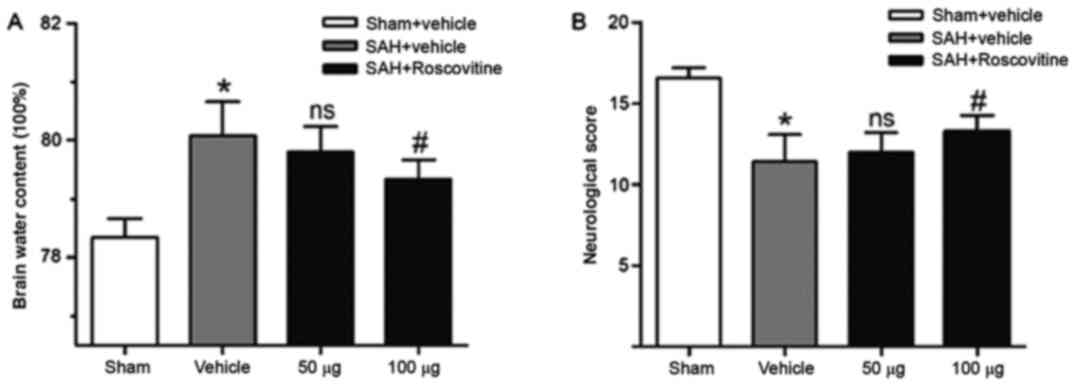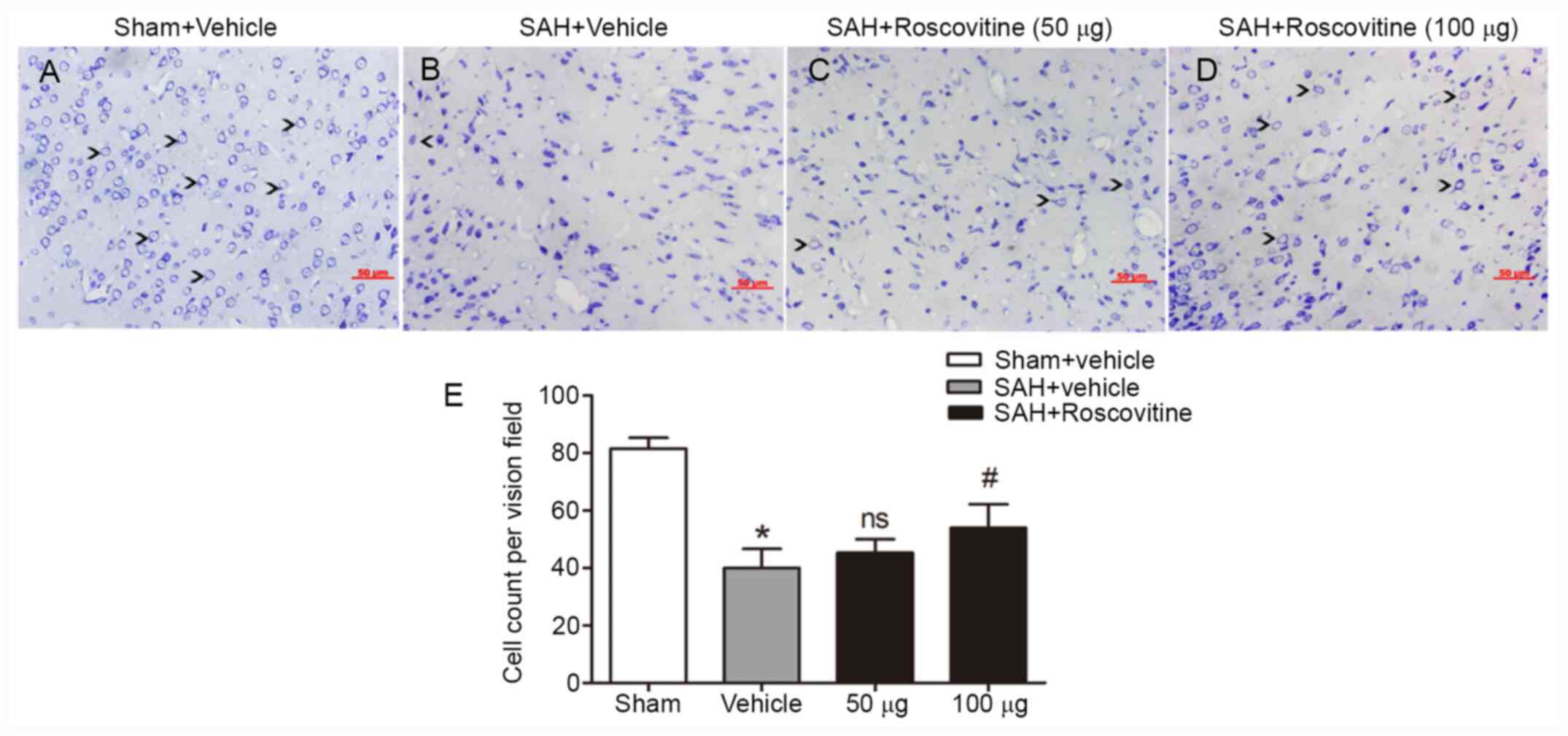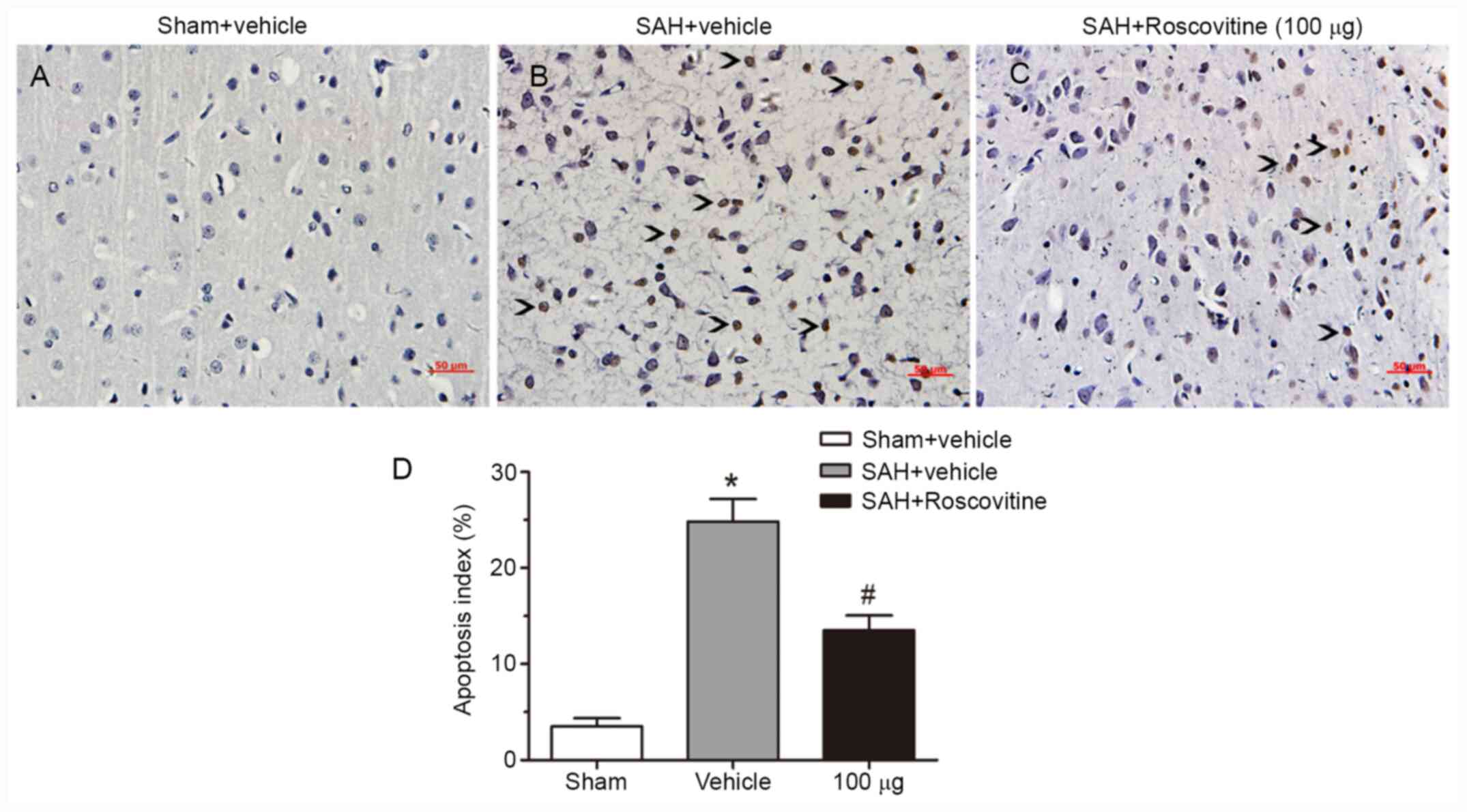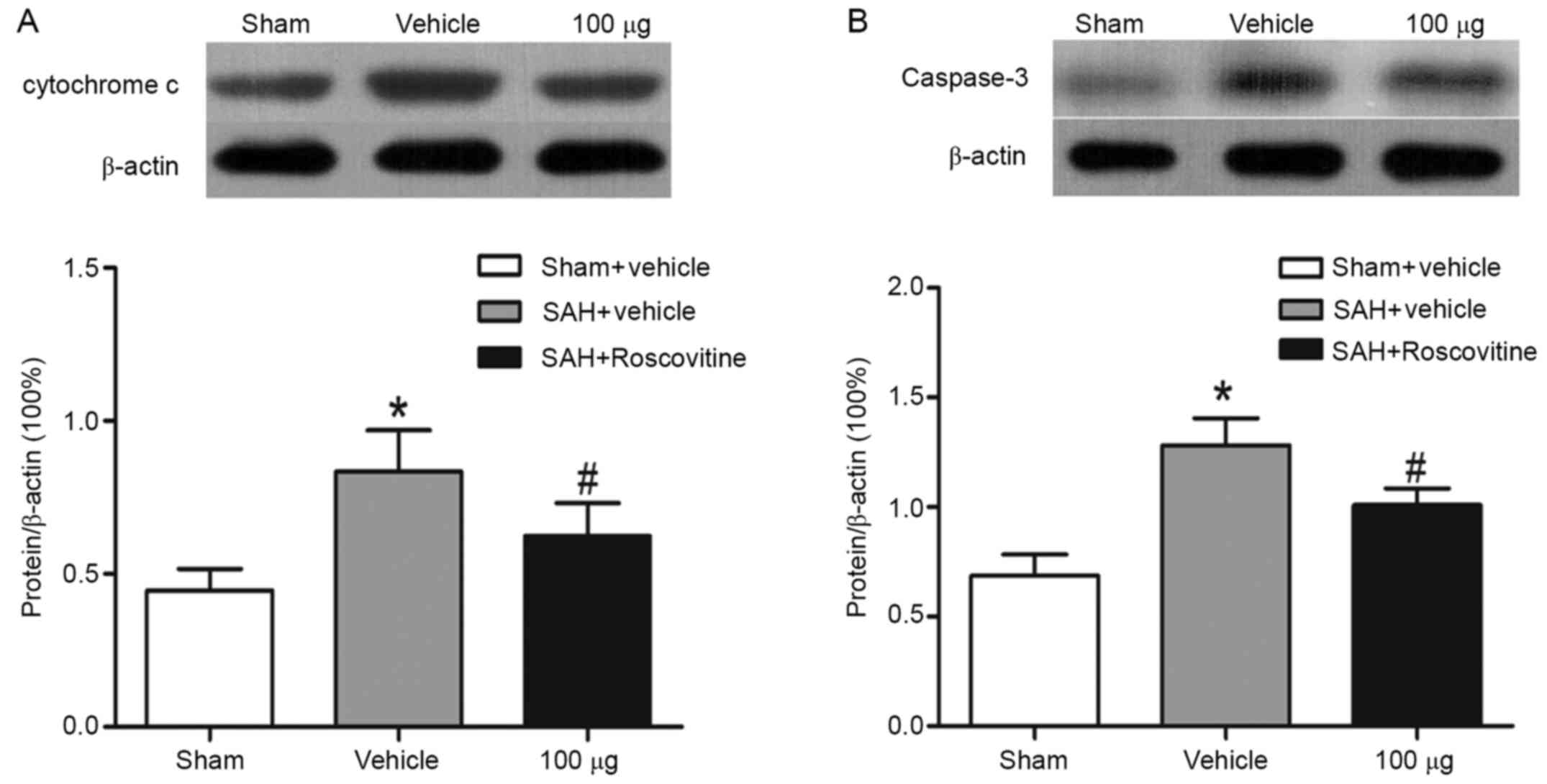|
1
|
Connolly ES Jr, Rabinstein AA, Carhuapoma
JR, Derdeyn CP, Dion J, Higashida RT, Hoh BL, Kirkness CJ, Naidech
AM, Ogilvy CS, et al: Guidelines for the management of aneurysmal
subarachnoid hemorrhage: A guideline for healthcare professionals
from the American heart association/american stroke association.
Stroke. 43:1711–1737. 2012.PubMed/NCBI View Article : Google Scholar
|
|
2
|
Hop JW, Rinkel GJ, Algra A and van Gijn J:
Case-fatality rates and functional outcome after subarachnoid
hemorrhage: A systematic review. Stroke. 28:660–664.
1997.PubMed/NCBI View Article : Google Scholar
|
|
3
|
Mackey J, Khoury JC, Alwell K, Moomaw CJ,
Kissela BM, Flaherty ML, Adeoye O, Woo D, Ferioli S, De Los Rios La
Rosa F, et al: Stable incidence but declining case-fatality rates
of subarachnoid hemorrhage in a population. Neurology.
87:2192–2197. 2016.PubMed/NCBI View Article : Google Scholar
|
|
4
|
Macdonald RL, Kassell NF, Mayer S,
Ruefenacht D, Schmiedek P, Weidauer S, Frey A, Roux S and Pasqualin
A: CONSCIOUS-1 Investigators. Clazosentan to overcome neurological
ischemia and infarction occurring after subarachnoid hemorrhage
(CONSCIOUS-1): Randomized, double-blind, placebo-controlled phase 2
dose-finding trial. Stroke. 39:3015–3021. 2008.PubMed/NCBI View Article : Google Scholar
|
|
5
|
Sehba FA, Hou J, Pluta RM and Zhang JH:
The importance of early brain injury after subarachnoid hemorrhage.
Prog Neurobiol. 97:14–37. 2012.PubMed/NCBI View Article : Google Scholar
|
|
6
|
Chaudhry SR, Kahlert UD, Kinfe TM, Endl E,
Dolf A, Niemelä M, Hänggi D and Muhammad S: Differential
polarization and activation dynamics of systemic T helper cell
subsets after aneurysmal subarachnoid hemorrhage (SAH) and during
post-SAH complications. Sci Rep. 11(14226)2021.PubMed/NCBI View Article : Google Scholar
|
|
7
|
Liu L, Kawakita F, Fujimoto M, Nakano F,
Imanaka-Yoshida K, Yoshida T and Suzuki H: Role of periostin in
early brain injury after subarachnoid hemorrhage in mice. Stroke.
48:1108–1111. 2017.PubMed/NCBI View Article : Google Scholar : Suzuki H, Ayer R,
Sugawara T, Chen W, Sozen T, Hasegawa Y, Kanamaru K and Zhang JH:
Protective effects of recombinant osteopontin on early brain injury
after subarachnoid hemorrhage in rats. Crit Care Med 38: 612-618,
2010.
|
|
8
|
Uekawa K, Hasegawa Y, Ma M, Nakagawa T,
Katayama T, Sueta D, Toyama K, Kataoka K, Koibuchi N, Kawano T, et
al: Rosuvastatin ameliorates early brain injury after subarachnoid
hemorrhage via suppression of superoxide formation and nuclear
factor-kappa B activation in rats. J Stroke Cerebrovasc Dis.
23:1429–1439. 2014.PubMed/NCBI View Article : Google Scholar
|
|
9
|
Feng D, Wang W, Dong Y, Wu L, Huang J, Ma
Y, Zhang Z, Wu S, Gao G and Qin H: Ceftriaxone alleviates early
brain injury after subarachnoid hemorrhage by increasing excitatory
amino acid transporter 2 expression via the PI3K/Akt/NF-κB
signaling pathway. Neuroscience. 268:21–32. 2014.PubMed/NCBI View Article : Google Scholar
|
|
10
|
Wang Z, Guo S, Wang J, Shen Y, Zhang J and
Wu Q: Nrf2/HO-1 mediates the neuroprotective effect of mangiferin
on early brain injury after subarachnoid hemorrhage by attenuating
mitochondria-related apoptosis and neuroinflammation. Sci Rep.
7(11883)2017.PubMed/NCBI View Article : Google Scholar
|
|
11
|
Mo J, Enkhjargal B, Travis ZD, Zhou K, Wu
P, Zhang G, Zhu Q, Zhang T, Peng J, Xu W, et al: AVE 0991
attenuates oxidative stress and neuronal apoptosis via
Mas/PKA/CREB/UCP-2 pathway after subarachnoid hemorrhage in rats.
Redox Biol. 20:75–86. 2019.PubMed/NCBI View Article : Google Scholar
|
|
12
|
Pang J, Chen Y, Kuai L, Yang P, Peng J, Wu
Y, Chen Y, Vitek MP, Chen L, Sun X and Jiang Y: Inhibition of
blood-brain barrier disruption by an apolipoprotein E-mimetic
peptide ameliorates early brain injury in experimental subarachnoid
hemorrhage. Transl Stroke Res. 8:257–272. 2017.PubMed/NCBI View Article : Google Scholar
|
|
13
|
Mangold N, Pippin J, Unnersjoe-Jess D,
Koehler S, Shankland S, Brähler S, Schermer B, Benzing T,
Brinkkoetter PT and Hagmann H: The atypical cyclin-dependent kinase
5 (Cdk5) guards podocytes from apoptosis in glomerular disease
while being dispensable for podocyte development. Cells.
10(2464)2021.PubMed/NCBI View Article : Google Scholar
|
|
14
|
Roufayel R and Murshid N: CDK5: Key
regulator of apoptosis and cell survival. Biomedicines.
7(88)2019.PubMed/NCBI View Article : Google Scholar
|
|
15
|
Shah K and Lahiri DK: A tale of the good
and bad: Remodeling of the microtubule network in the brain by
Cdk5. Mol Neurobiol. 54:2255–2268. 2017.PubMed/NCBI View Article : Google Scholar
|
|
16
|
Sharma S and Sicinski P: . A kinase of
many talents: Non-neuronal functions of CDK5 in development and
disease. Open Biol. 10(190287)2020.PubMed/NCBI View Article : Google Scholar
|
|
17
|
Mushtaq G, Greig NH, Anwar F, Al-Abbasi
FA, Zamzami MA, Al-Talhi HA and Kamal MA: Neuroprotective
mechanisms mediated by CDK5 inhibition. Curr Pharm Des. 22:527–534.
2016.PubMed/NCBI View Article : Google Scholar
|
|
18
|
Menn B, Bach S, Blevins TL, Campbell M,
Meijer L and Timsit S: Delayed treatment with systemic
(S)-roscovitine provides neuroprotection and inhibits in vivo CDK5
activity increase in animal stroke models. PLoS One.
5(e12117)2010.PubMed/NCBI View Article : Google Scholar
|
|
19
|
Tuo QZ, Liuyang ZY, Lei P, Yan X, Shentu
YP, Liang JW, Zhou H, Pei L, Xiong Y, Hou TY, et al: Zinc induces
CDK5 activation and neuronal death through CDK5-Tyr15
phosphorylation in ischemic stroke. Cell Death Dis.
9(870)2018.PubMed/NCBI View Article : Google Scholar
|
|
20
|
Zhou YF, Wang J, Deng MF, Chi B, Wei N,
Chen JG, Liu D, Yin X, Lu Y and Zhu LQ: The peptide-directed
lysosomal degradation of CDK5 exerts therapeutic effects against
stroke. Aging Dis. 10:1140–1145. 2019.PubMed/NCBI View Article : Google Scholar
|
|
21
|
Kumar S, Rajput MK and Tickoo SB: Laws,
regulations, policies and guidelines governing the care and use of
laboratory animals. Essentials of laboratory animal science:
Principles and practices. Springer, Singapore, pp23-38, 2021.
|
|
22
|
Sun Q, Dai Y, Zhang X, Hu YC, Zhang D, Li
W, Zhang XS, Zhu JH, Zhou ML and Hang CH: Expression and cell
distribution of myeloid differentiation primary response protein 88
in the cerebral cortex following experimental subarachnoid
hemorrhage in rats: A pilot study. Brain Res. 1520:134–144.
2013.PubMed/NCBI View Article : Google Scholar
|
|
23
|
Wang KC, Tang SC, Lee JE, Tsai JC, Lai DM,
Lin WC, Lin CP, Tu YK and Hsieh ST: Impaired microcirculation after
subarachnoid hemorrhage in an in vivo animal model. Sci Rep.
8(13315)2018.PubMed/NCBI View Article : Google Scholar
|
|
24
|
Li R, Liu W, Yin J, Chen Y, Guo S, Fan H,
Li X, Zhang X, He X and Duan C: TSG-6 attenuates
inflammation-induced brain injury via modulation of microglial
polarization in SAH rats through the SOCS3/STAT3 pathway. J
Neuroinflammation. 15(231)2018.PubMed/NCBI View Article : Google Scholar
|
|
25
|
Lee JY, Sagher O, Keep R, Hua Y and Xi G:
Comparison of experimental rat models of early brain injury after
subarachnoid hemorrhage. Neurosurgery. 65:331–343. 2009.PubMed/NCBI View Article : Google Scholar
|
|
26
|
Hilton GD, Stoica BA, Byrnes KR and Faden
AI: Roscovitine reduces neuronal loss, glial activation, and
neurologic deficits after brain trauma. J Cereb Blood Flow Metab.
28:1845–1859. 2008.PubMed/NCBI View Article : Google Scholar
|
|
27
|
Nicolás P, Lassalle VL and Ferreira ML:
Quantification of immobilized Candida antarctica lipase B (CALB)
using ICP-AES combined with Bradford method. Enzyme Microb Technol.
97:97–103. 2017.PubMed/NCBI View Article : Google Scholar
|
|
28
|
Zhuang Z, Zhou ML, You WC, Zhu L, Ma CY,
Sun XJ and Shi JX: Hydrogen-rich saline alleviates early brain
injury via reducing oxidative stress and brain edema following
experimental subarachnoid hemorrhage in rabbits. BMC Neurosci.
13(47)2012.PubMed/NCBI View Article : Google Scholar
|
|
29
|
Garcia JH, Wagner S, Liu KF and Hu XJ:
Neurological deficit and extent of neuronal necrosis attributable
to middle cerebral artery occlusion in rats. Statistical
validation. Stroke. 26:627–635. 1995.PubMed/NCBI View Article : Google Scholar
|
|
30
|
Liu X, Feng Z, Du L, Huang Y, Ge J, Deng Y
and Mei Z: The potential role of MicroRNA-124 in cerebral ischemia
injury. Int J Mol Sci. 21(120)2019.PubMed/NCBI View Article : Google Scholar
|
|
31
|
Cheng X, Xu S, Zhang C, Qin K, Yan J and
Shao X: The BRCC3 regulated by Cdk5 promotes the activation of
neuronal NLRP3 inflammasome in Parkinson's disease models. Biochem
Biophys Res Commun. 522:647–654. 2020.PubMed/NCBI View Article : Google Scholar
|
|
32
|
Ji YB, Zhuang PP, Ji Z, Wu YM, Gu Y, Gao
XY, Pan SY and Hu YF: TFP5 peptide, derived from CDK5-activating
cofactor p35, provides neuroprotection in early-stage of adult
ischemic stroke. Sci Rep. 7(40013)2017.PubMed/NCBI View Article : Google Scholar
|
|
33
|
Shupp A, Casimiro MC and Pestell RG:
Biological functions of CDK5 and potential CDK5 targeted clinical
treatments. Oncotarget. 8:17373–17382. 2017.PubMed/NCBI View Article : Google Scholar
|
|
34
|
Zhang B, Tan VB, Lim KM and Tay TE: The
activation and inhibition of cyclin-dependent kinase-5 by
phosphorylation. Biochemistry. 46:10841–10851. 2007.PubMed/NCBI View Article : Google Scholar
|
|
35
|
Ko YU, Kim C, Lee J, Kim D, Kim Y, Yun N
and Oh YJ: Site-specific phosphorylation of Fbxw7 by Cdk5/p25 and
its resulting decreased stability are linked to glutamate-induced
excitotoxicity. Cell Death Dis. 10(579)2019.PubMed/NCBI View Article : Google Scholar
|
|
36
|
Lee MS, Kwon YT, Li M, Peng J, Friedlander
RM and Tsai LH: Neurotoxicity induces cleavage of p35 to p25 by
calpain. Nature. 405:360–364. 2000.PubMed/NCBI View Article : Google Scholar
|
|
37
|
Zhang H, Chang L, Zhang H, Nie J, Zhang Z,
Yang X, Vuong AM, Wang Z, Chen A and Niu Q: Calpain-2/p35-p25/Cdk5
pathway is involved in the neuronal apoptosis induced by
polybrominated diphenyl ether-153. Toxicol Lett. 277:41–53.
2017.PubMed/NCBI View Article : Google Scholar
|
|
38
|
Tucker D, Lu Y and Zhang Q: From
mitochondrial function to neuroprotection-an emerging role for
methylene blue. Mol Neurobiol. 55:5137–5153. 2018.PubMed/NCBI View Article : Google Scholar
|
|
39
|
Sénécal V, Barat C and Tremblay MJ: The
delicate balance between neurotoxicity and neuroprotection in the
context of HIV-1 infection. Glia. 69:255–280. 2021.PubMed/NCBI View Article : Google Scholar
|
|
40
|
Tiernan CT, Ginsberg SD, He B, Ward SM,
Guillozet-Bongaarts AL, Kanaan NM, Mufson EJ and Counts SE:
Pretangle pathology within cholinergic nucleus basalis neurons
coincides with neurotrophic and neurotransmitter receptor gene
dysregulation during the progression of Alzheimer's disease.
Neurobiol Dis. 117:125–136. 2018.PubMed/NCBI View Article : Google Scholar
|
|
41
|
Sun YQ, Xie JW, Xie HT, Chen PC, Zhang XL,
Zheng CH, Li P, Wang JB, Lin JX, Cao LL, et al: Expression of CRM1
and CDK5 shows high prognostic accuracy for gastric cancer. World J
Gastroenterol. 23:2012–2022. 2017.PubMed/NCBI View Article : Google Scholar
|
|
42
|
Ruegsegger GN, Toedebusch RG, Childs TE,
Grigsby KB and Booth FW: Loss of Cdk5 function in the nucleus
accumbens decreases wheel running and may mediate age-related
declines in voluntary physical activity. J Physiol. 595:363–384.
2017.PubMed/NCBI View Article : Google Scholar
|
|
43
|
Tanabe J, Nakahara I, Matsumoto S, Suyama
Y, Morioka J, Oda J, Hasebe A, Suzuki T, Watanabe S, Suyama K, et
al: Cortical blood flow insufficiency scores with computed
tomography perfusion can predict outcomes in aneurysmal
subarachnoid hemorrhage patients: A cohort study. Neurocrit Care.
34:946–955. 2021.PubMed/NCBI View Article : Google Scholar
|
|
44
|
Qian C, Jin J, Chen J, Li J, Yu X, Mo H
and Chen G: SIRT1 activation by resveratrol reduces brain edema and
neuronal apoptosis in an experimental rat subarachnoid hemorrhage
model. Mol Med Rep. 16:9627–9635. 2017.PubMed/NCBI View Article : Google Scholar
|
|
45
|
Shamsi Meymandi M, Soltani Z, Sepehri G,
Amiresmaili S, Farahani F and Moeini Aghtaei M: Effects of
pregabalin on brain edema, neurologic and histologic outcomes in
experimental traumatic brain injury. Brain Res Bull. 140:169–175.
2018.PubMed/NCBI View Article : Google Scholar
|
|
46
|
Liu XC, Wu CZ, Hu XF, Wang TL, Jin XP, Ke
SF, Wang E and Wu G: Gastrodin attenuates neuronal apoptosis and
neurological deficits after experimental intracerebral hemorrhage.
J Stroke Cerebrovasc Dis. 29(104483)2020.PubMed/NCBI View Article : Google Scholar
|
|
47
|
Sadeghian N, Shadman J, Moradi A, Ghasem
Golmohammadi M and Panahpour H: Calcitriol protects the blood-brain
barrier integrity against ischemic stroke and reduces vasogenic
brain edema via antioxidant and antiapoptotic actions in rats.
Brain Res Bull. 150:281–289. 2019.PubMed/NCBI View Article : Google Scholar
|
|
48
|
Sun J and Nan G: The extracellular
signal-regulated kinase 1/2 pathway in neurological diseases: A
potential therapeutic target (review). Int J Mol Med. 39:1338–1346.
2017.PubMed/NCBI View Article : Google Scholar
|
|
49
|
Huang YH, Chung CL, Tsai HP, Tzou RD, Wu
SC, Chai CY, Lee TC and Kwan AL: Impact of hyperglycemia on
neuronal apoptosis after subarachnoid hemorrhage in rodent brain:
An experimental research. Int J Surg. 83:246–252. 2020.PubMed/NCBI View Article : Google Scholar
|
|
50
|
Yadav N, Gogada R, O'Malley J, Gundampati
RK, Jayanthi S, Hashmi S, Lella R, Zhang D, Wang J, Kumar R, et al:
Molecular insights on cytochrome c and nucleotide regulation of
apoptosome function and its implication in cancer. Biochim Biophys
Acta Mol Cell Res. 1867(118573)2020.PubMed/NCBI View Article : Google Scholar
|
|
51
|
Guo MY, Shang L, Hu YY, Jiang LP, Wan YY,
Zhou QQ, Zhang K, Liao HF, Yi JL and Han XJ: The role of
Cdk5-mediated Drp1 phosphorylation in Aβ1-42 induced
mitochondrial fission and neuronal apoptosis. J Cell Biochem.
119:4815–4825. 2018.PubMed/NCBI View Article : Google Scholar
|
|
52
|
Seager R, Lee L, Henley JM and Wilkinson
KA: Mechanisms and roles of mitochondrial localisation and dynamics
in neuronal function. Neuronal Signal. 4(NS20200008)2020.PubMed/NCBI View Article : Google Scholar
|
|
53
|
Kim JE, Park H, Choi SH, Kong MJ and Kang
TC: Roscovitine attenuates microglia activation and monocyte
infiltration via p38 MAPK inhibition in the rat frontoparietal
cortex following status epilepticus. Cells. 8(746)2019.PubMed/NCBI View Article : Google Scholar
|
|
54
|
Kartha CC: Cell cycle regulation in
cardiomyocytes. In: Cardiomyocytes in health and disease. Springer,
Cham, pp25-39, 2021.
|
|
55
|
Chao AC, Chen CH, Wu MH, Hou BY and Yang
DI: Roles of Id1/HIF-1 and CDK5/HIF-1 in cell cycle reentry induced
by amyloid-beta peptide in post-mitotic cortical neuron. Biochim
Biophys Acta Mol Cell Res. 1867(118628)2020.PubMed/NCBI View Article : Google Scholar
|
|
56
|
Cortés N, Guzmán-Martínez L, Andrade V,
González A and Maccioni RB: CDK5: A unique CDK and its multiple
roles in the nervous system. J Alzheimers Dis. 68:843–855.
2019.PubMed/NCBI View Article : Google Scholar
|
|
57
|
Chen SD, Yang JL, Lin YC, Chao AC and Yang
DI: Emerging roles of inhibitor of differentiation-1 in Alzheimer's
disease: Cell cycle reentry and beyond. Cells.
9(1746)2020.PubMed/NCBI View Article : Google Scholar
|
|
58
|
Lee J, Ko YU, Chung Y, Yun N, Kim M, Kim K
and Oh YJ: The acetylation of cyclin-dependent kinase 5 at lysine
33 regulates kinase activity and neurite length in hippocampal
neurons. Sci Rep. 8(13676)2018.PubMed/NCBI View Article : Google Scholar
|















